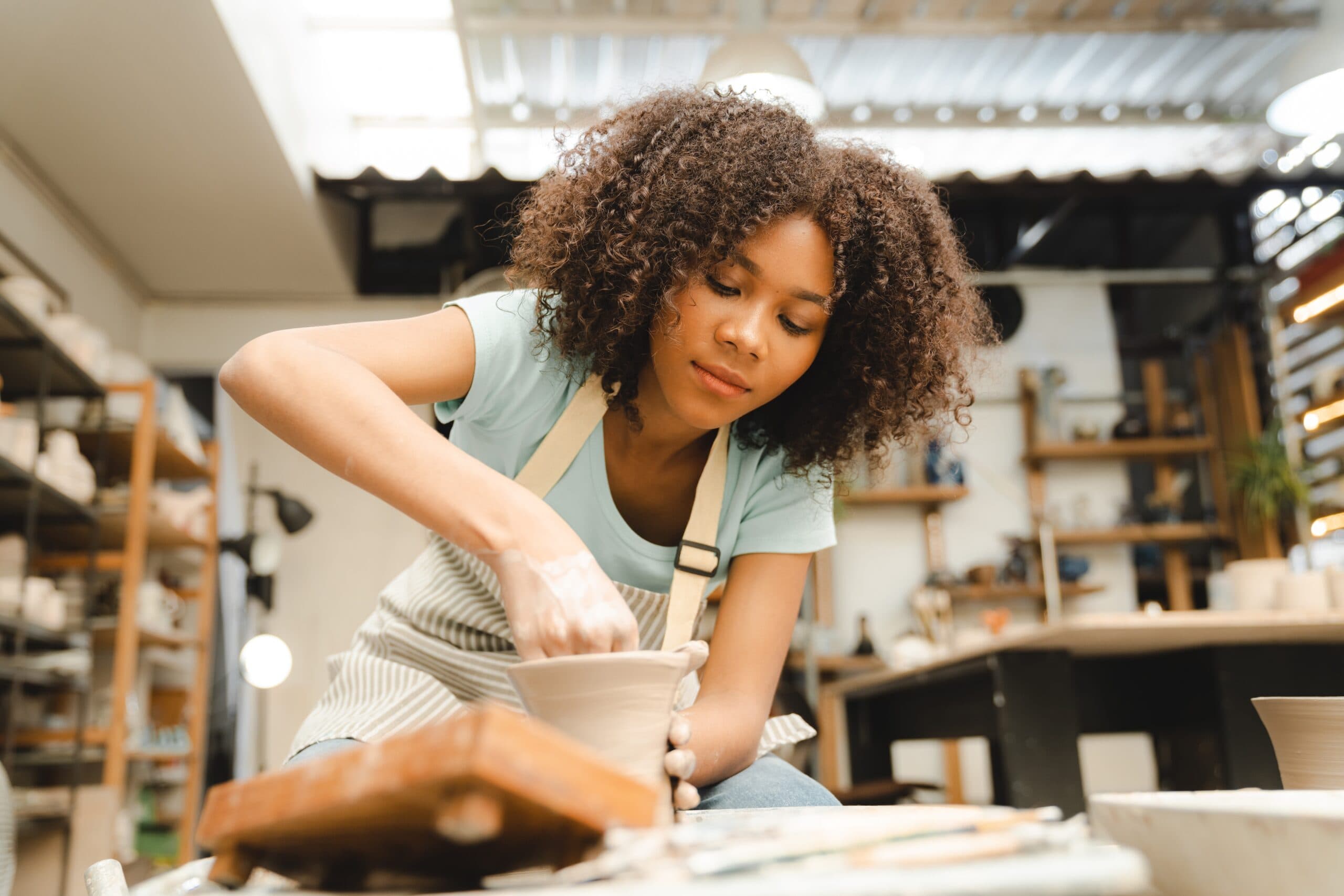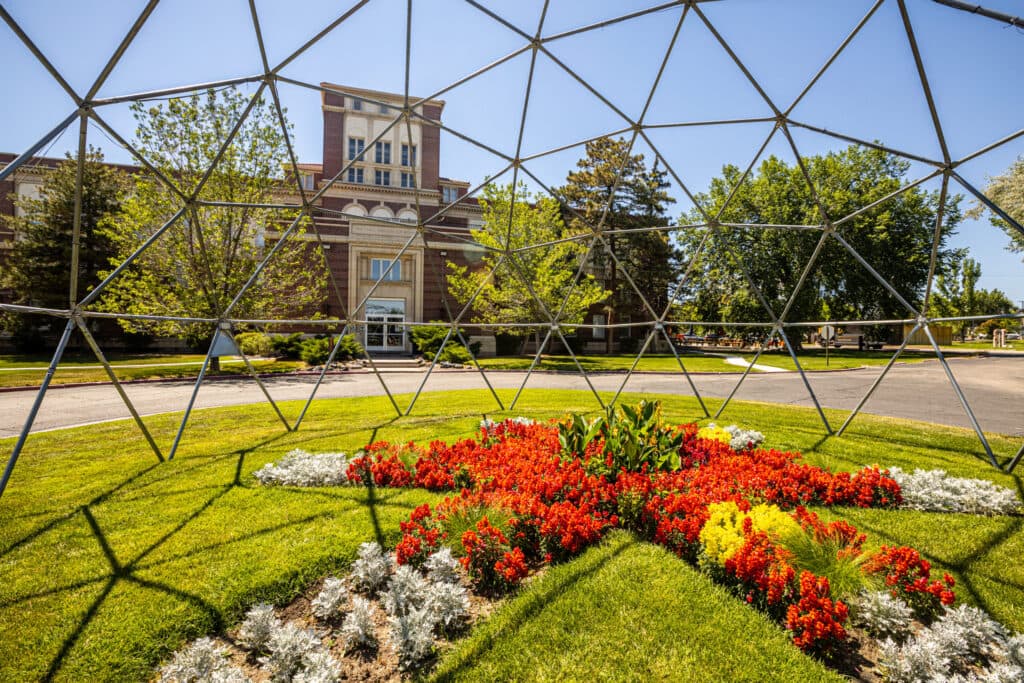Do you enjoy working with clay? Dream of making a name for yourself as a skilled ceramic artist or sculptor? If so, then learning the ins and outs of contemporary ceramics is a must—and the best way to gain this essential knowledge and skill is to enroll in a fine arts program that explores ceramics in depth.
At Rocky Mountain College of Art + Design (RMCAD), we’re proud to offer a bachelor’s degree in fine arts that explores art and design principles in the creation of functional and sculptural ceramics. We also believe that aspiring artists can learn a great deal from contemporary and modern pottery artists, which we’ll cover in the sections that follow.
Is a career in ceramics right for you? Let’s dive into the essence of ceramics, common techniques in ceramic art and some of the most masterful ceramic artists of our time.
The Essence of Ceramics
Ceramic art refers to any work of art made from ceramic materials. Clay is the most common material used in this form of art, though there are many different types of clay that can be used to create such materials as earthenware pottery, stoneware, bone china and porcelain. Ultimately, the finished product and material depend on the type of clay used as well as the firing conditions and other techniques the artist followed.
Ceramic art can also manifest in a variety of forms, including:
- Functional wares (such as tableware)
- Non-functional wares (such as sculptures)
- Figurines
- Ceramic or stone tiles
The history of ceramic art is believed to date back at least 20,000 years to areas like China, Japan and East Asia. Today, ceramic art in its many forms can be found in art museums, homes, businesses and just about anywhere else you can imagine. Ceramic art can be functional, decorative or purely a form of artistic expression—and no two pieces are exactly alike.
Techniques and Styles in Ceramic Art
Those interested in exploring ceramic art should familiarize themselves with popular techniques and styles in the field. Some of the most essential techniques ceramic artists must learn early on include:
- Hand building – This refers specifically to the way hands are used to shape clay, which often (but not always) involves the use of a wheel and centrifugal force to create a desired shape.
- Pinching – The pinching technique is used to knead clay into a ball. Then, the artist presses down into the middle of the clay ball while working around in circles to achieve the desired shape. This technique is used less commonly than hand building, but it can be effective for creating a truly unique piece with imperfections that give it more character.
- Wheel throwing – This ceramic technique involves a ball of clay being thrown onto a spinning wheel. Then, water is poured over the clay, and the artist holds the clay onto the wheel with one hand while shaping it with the other hand.
- Slip casting – Another common technique used in ceramic art is slip casting, where liquid clay (known as slip) is poured into a plaster mold that absorbs excess water. From there, the slip becomes thicker the longer it is left in the mold, and excess slip is poured out from the mold as needed until achieving the desired shape and form.
In addition to basic ceramic shaping methods, other more specialized techniques artists may need to learn include ceramic glazing techniques and decorating techniques that can really take designs to the next level.
Renowned Ceramic Artists and Their Contributions
Aspiring ceramic artists can gain inspiration by exploring the works of some of the most famous ceramicists below. If you are particularly inspired by any of these artists, you might even want to research ceramic exhibitions where you can see their work in person.
Bernard Leach
Often considered “the Father of British studio pottery,” Bernard Leach lived from 1887 to 1979 and was both a studio potter and art teacher. He produced work until 1972 and ran his own pottery studio, Leach Pottery, which is still open today.
Lucie Rie
Born in Austria in 1902, Lucie Rie was a ceramics artist known for her modernist forms and use of bright, vibrant colors in her work. She ran her own small studio and eventually went on to teach at the Camberwell School of Art until 1971.
Peter Voulkos
One of many ceramic sculpture artists of his time, Peter Voulkos was known for his large clay sculptures that were cast in bronze. He was most notable for perpetuating the (then-novel) concept that ceramic art did not have to be functional to be celebrated. For much of his career, he taught ceramics at Black Mountain College in California.
Beatrice Wood
An American artist, Beatrice Wood was best known for her luster-glazed ceramic pieces. Although born in New York, she spent a lot of time studying art in France before returning home to the United States during World War I. Currently, hundreds of her ceramics works are still in circulation.
Shoji Hamada
Shoji Hamada was a Japanese ceramic artist known for her involvement in the mingei folk-art movement in Japan. She was inspired by ceramicist Bernard Leach and went on to help him establish his own studio in Mashiko, Japan.
Magdalene Odundo
Born in Nairobi and raised in different areas of Kenya and India, Magdalene Odundo continues to make an impact on the ceramics world through her continued work and teaching. She has been hosted as an artist in residence at many famous art studios, including The Clay Studio in Philadelphia.
Ken Price
Ken Price, who lived from 1935 until 2012, was an American artist most recognized for his small-scale ceramic sculptures made to resemble a vast spectrum of unique shapes and forms. Today, you can still see much of his work in various collections at the Museum of Modern Art in New York, the Art Institute of Chicago and many others.
Grayson Perry
As a contemporary British artist, Grayson Perry is best known for his ceramics, though he has also tapped into other art forms that include tapestries and design. You can find his ceramics collections and other work at the Museum of Modern Art and the Tate Gallery in London.
Ruth Duckworth
Recognized for her smooth ceramic works of abstract forms inspired by nature, Ruth Duckworth was a British sculptor who lived from 1919 until 2009. During her career as a ceramic artist, she held positions as a tombstone engraver in England and an art teacher at the University of Chicago.
Edmund de Waal
Edmund de Waal, who is still sculpting today, is a British artist known for his large-scale pottery pieces. He lives in London, and his work can be seen on display at the Victoria and Albert Museum in London as well as the Museum of Fine Arts in Houston and the Museum of Arts and Design in New York.
Akio Takamori
Akio Takamori was a Japanese-American sculptor whose work was heavily inspired by human forms. Along with his work as a ceramics artist, he also taught art at the University of Washington.
Maria Martinez
Maria Martinez, celebrated for revitalizing Pueblo pottery, transformed the ceramic art world with her innovative black-on-black technique, marrying traditional Pueblo methods with her artistic vision. Born in New Mexico’s San Ildefonso Pueblo, she, alongside her husband Julian, rediscovered and popularized this method, earning international acclaim. Her work, which involved painting matte designs onto polished black surfaces, is revered in museums worldwide and continues to inspire artists and collectors alike. Martinez’s legacy is a testament to the power of blending tradition with innovation, preserving Indigenous American pottery traditions while introducing them to a global audience, making her an iconic figure in American ceramics.
Betty Woodman
Betty Woodman was a ceramic artist famous for her colorful yet functional work in the 1970s. Today, her art can be found in collections at the Museum of Fine Arts in Boston, the Museum of Modern Art in New York and others. She passed away in 2018.
Isamu Noguchi
An American sculptor, Isamu Noguchi is renowned for his experimental works, including the famous Red Cube that can still be seen in Manhattan Plaza. You can see his art and learn more about him at the Noguchi Foundation and Garden Museum in Long Island.
Jennifer Lee
Jennifer Lee is a Scottish ceramic artist known for her hand-built pots made using more traditional methods, such as pinch and coil. She is also known for coloring her clay before shaping it using a mix of metallic oxides.
Teaster Gates
Teaster Gates is a ceramic artist and art professor who teaches at the University of Chicago. Best known for his clay work and social practice, he works with a wide range of materials and mediums.
The Artistic Process of Ceramic Artists
While every ceramic artist develops their own process throughout their career, there is a basic process most ceramic projects follow. This begins with coming up with ceramic or pottery design ideas and then preparing the clay, which may come in the form of earthenware clay, porcelain, stoneware or bone china. Typically, clay needs to be wedged (which involves mixing together the soft and hard spots in the clay) in order to make it more pliable and workable.
Next, clay is formed based on the specific technique the artist chooses (pinching, hand building, slip casting, etc.). If the artist desires, the clay may also be decorated with finishing touches (whether by carving or painting) before it is fired in a kiln. These kilns can reach temperatures of up to 1,800 degrees Fahrenheit, depending on the pottery studio setup. Firing is an essential step in the process, as this will harden the clay and make it less fragile.
After firing in the kiln, ceramic pieces can be glazed to create a finished look. There are many different ceramic glazing techniques to consider depending on the artist’s goals. Some common glazing techniques include:
- Dipping
- Pouring or dripping
- Brushing
- Splattering
- Sponging
- Stippling
- Spraying
The Future of Ceramic Art
Only time will tell what the future of ceramic art has in store, but if the work of these masterful artists is any indication, we have plenty to look forward to. According to ceramic artist Lauren Sandler, “Ceramics today is a microcosm of the art of the last century, rooted in expression and possibility.” From the earliest of techniques and styles to the modern ceramics we see nowadays, this dynamic form of art continues to evolve with exciting new applications and adaptations.
Are you ready to not just witness but also take part in the future of ceramic art? If so, a bachelor’s degree in fine arts from RMCAD is an excellent starting point. This program empowers students to master their chosen artistic mediums in a supportive and creative environment, with program highlights ranging from painting and ceramics to sculpture, printmaking and photography.
Learn more about RMCAD’s undergraduate fine arts degree program by getting in touch today or getting started with your application.

